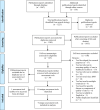Assessing the quality of care for children attending health facilities: a systematic review of assessment tools
- PMID: 34607894
- PMCID: PMC8491295
- DOI: 10.1136/bmjgh-2021-006804
Assessing the quality of care for children attending health facilities: a systematic review of assessment tools
Abstract
Introduction: Assessing quality of healthcare is integral in determining progress towards equitable health outcomes worldwide. Using the WHO 'Standards for improving quality of care for children and young adolescents in health facilities' as a reference standard, we aimed to evaluate existing tools that assess quality of care for children.
Methods: We undertook a systematic literature review of publications/reports between 2008 and 2020 that reported use of quality of care assessment tools for children (<15 years) in health facilities. Identified tools were reviewed against the 40 quality statements and 510 quality measures from the WHO Standards to determine the extent each tool was consistent with the WHO Standards. The protocol was registered in PROSPERO ID: CRD42020175652.
Results: Nine assessment tools met inclusion criteria. Two hospital care tools developed by WHO-Europe and WHO-South-East Asia Offices had the most consistency with the WHO Standards, assessing 291 (57·1%) and 208 (40·8%) of the 510 quality measures, respectively. Remaining tools included between 33 (6·5%) and 206 (40·4%) of the 510 quality measures. The WHO-Europe tool was the only tool to assess all 40 quality statements. The most common quality measures absent were related to experience of care, particularly provision of educational, emotional and psychosocial support to children and families, and fulfilment of children's rights during care.
Conclusion: Quality of care assessment tools for children in health facilities are missing some key elements highlighted by the WHO Standards. The WHO Standards are, however, extensive and applying all the quality measures in every setting may not be feasible. A consensus of key indicators to monitor the WHO Standards is required. Existing tools could be modified to include priority indicators to strengthen progress reporting towards delivering quality health services for children. In doing so, a balance between comprehensiveness and practical utility is needed.
Prospero registration number: CRD42020175652.
Keywords: child health; health systems evaluation; paediatrics; public health; systematic review.
© Author(s) (or their employer(s)) 2021. Re-use permitted under CC BY-NC. No commercial re-use. See rights and permissions. Published by BMJ.
Conflict of interest statement
Competing interests: We declare no competing interests. The authors alone are responsible for the views expressed in this article and they do not necessarily represent the views, decisions or policies of the institutions with which they are affiliated.
Figures




References
-
- Sustainable development goals knowledge platform New York: United nations, 2015. Available: https://sustainabledevelopment.un.org/sdgs [Accessed 30 Mar 2020].
-
- World Health Organization . Quality of care : a process for making strategic choices in health systems. Geneva: World Health Organization, 2006.
-
- World Health Organization . Standards for improving the quality of care for children and young adolescents in health facilities. Geneva: World Health Organization, 2018.
-
- World Health Organization . Standards for improving quality of maternal and newborn care in health facilities. Geneva: World Health Organization, 2016.
Publication types
MeSH terms
Grants and funding
LinkOut - more resources
Full Text Sources
Medical
Miscellaneous
